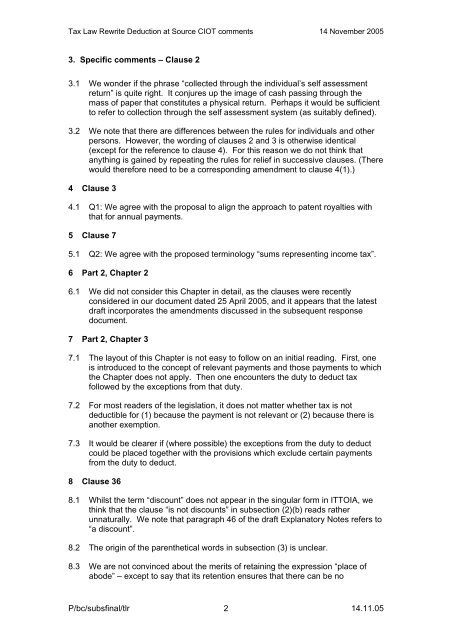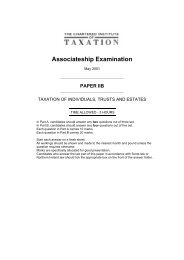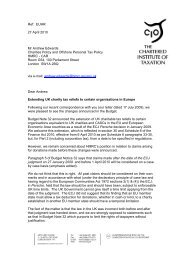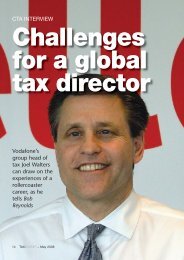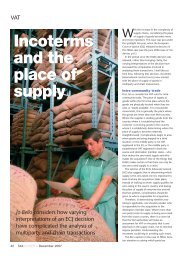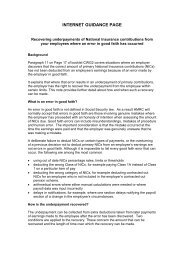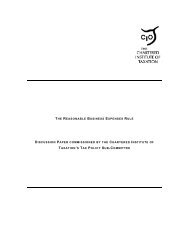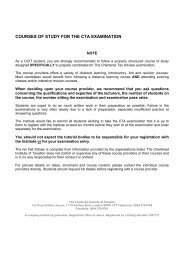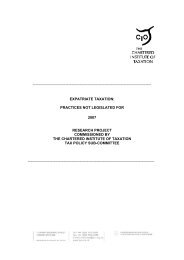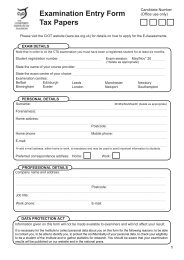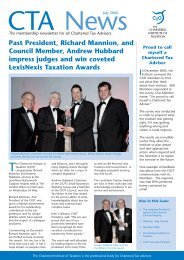Deductions at source - CIOT - The Chartered Institute of Taxation
Deductions at source - CIOT - The Chartered Institute of Taxation
Deductions at source - CIOT - The Chartered Institute of Taxation
You also want an ePaper? Increase the reach of your titles
YUMPU automatically turns print PDFs into web optimized ePapers that Google loves.
Tax Law Rewrite Deduction <strong>at</strong> Source <strong>CIOT</strong> comments 14 November 20053. Specific comments – Clause 23.1 We wonder if the phrase “collected through the individual’s self assessmentreturn” is quite right. It conjures up the image <strong>of</strong> cash passing through themass <strong>of</strong> paper th<strong>at</strong> constitutes a physical return. Perhaps it would be sufficientto refer to collection through the self assessment system (as suitably defined).3.2 We note th<strong>at</strong> there are differences between the rules for individuals and otherpersons. However, the wording <strong>of</strong> clauses 2 and 3 is otherwise identical(except for the reference to clause 4). For this reason we do not think th<strong>at</strong>anything is gained by repe<strong>at</strong>ing the rules for relief in successive clauses. (<strong>The</strong>rewould therefore need to be a corresponding amendment to clause 4(1).)4 Clause 34.1 Q1: We agree with the proposal to align the approach to p<strong>at</strong>ent royalties withth<strong>at</strong> for annual payments.5 Clause 75.1 Q2: We agree with the proposed terminology “sums representing income tax”.6 Part 2, Chapter 26.1 We did not consider this Chapter in detail, as the clauses were recentlyconsidered in our document d<strong>at</strong>ed 25 April 2005, and it appears th<strong>at</strong> the l<strong>at</strong>estdraft incorpor<strong>at</strong>es the amendments discussed in the subsequent responsedocument.7 Part 2, Chapter 37.1 <strong>The</strong> layout <strong>of</strong> this Chapter is not easy to follow on an initial reading. First, oneis introduced to the concept <strong>of</strong> relevant payments and those payments to whichthe Chapter does not apply. <strong>The</strong>n one encounters the duty to deduct taxfollowed by the exceptions from th<strong>at</strong> duty.7.2 For most readers <strong>of</strong> the legisl<strong>at</strong>ion, it does not m<strong>at</strong>ter whether tax is notdeductible for (1) because the payment is not relevant or (2) because there isanother exemption.7.3 It would be clearer if (where possible) the exceptions from the duty to deductcould be placed together with the provisions which exclude certain paymentsfrom the duty to deduct.8 Clause 368.1 Whilst the term “discount” does not appear in the singular form in ITTOIA, wethink th<strong>at</strong> the clause “is not discounts” in subsection (2)(b) reads r<strong>at</strong>herunn<strong>at</strong>urally. We note th<strong>at</strong> paragraph 46 <strong>of</strong> the draft Explan<strong>at</strong>ory Notes refers to“a discount”.8.2 <strong>The</strong> origin <strong>of</strong> the parenthetical words in subsection (3) is unclear.8.3 We are not convinced about the merits <strong>of</strong> retaining the expression “place <strong>of</strong>abode” – except to say th<strong>at</strong> its retention ensures th<strong>at</strong> there can be noP/bc/subsfinal/tlr 2 14.11.05


